Innovation and Creativity Report: Business Development Strategies
VerifiedAdded on 2020/05/16
|7
|1621
|256
Report
AI Summary
This report delves into the concepts of innovation and creativity within a business context, emphasizing their roles in achieving better business solutions and meeting evolving market demands. It defines innovation as the development and application of new ideas and methods, while creativity is presented as the process of generating something new. The report differentiates between the two, highlighting how creativity fuels innovation. It explores innovation variables, specifically focusing on structural, cultural, and human resource variables that foster innovation within an organization. Lendlease is used as a case study, illustrating how its open functional organizational structure, emphasis on collaboration, and focus on employee development contribute to its innovative culture. The report references various sources to support its analysis and provides insights into how organizations can leverage these variables to enhance innovation.
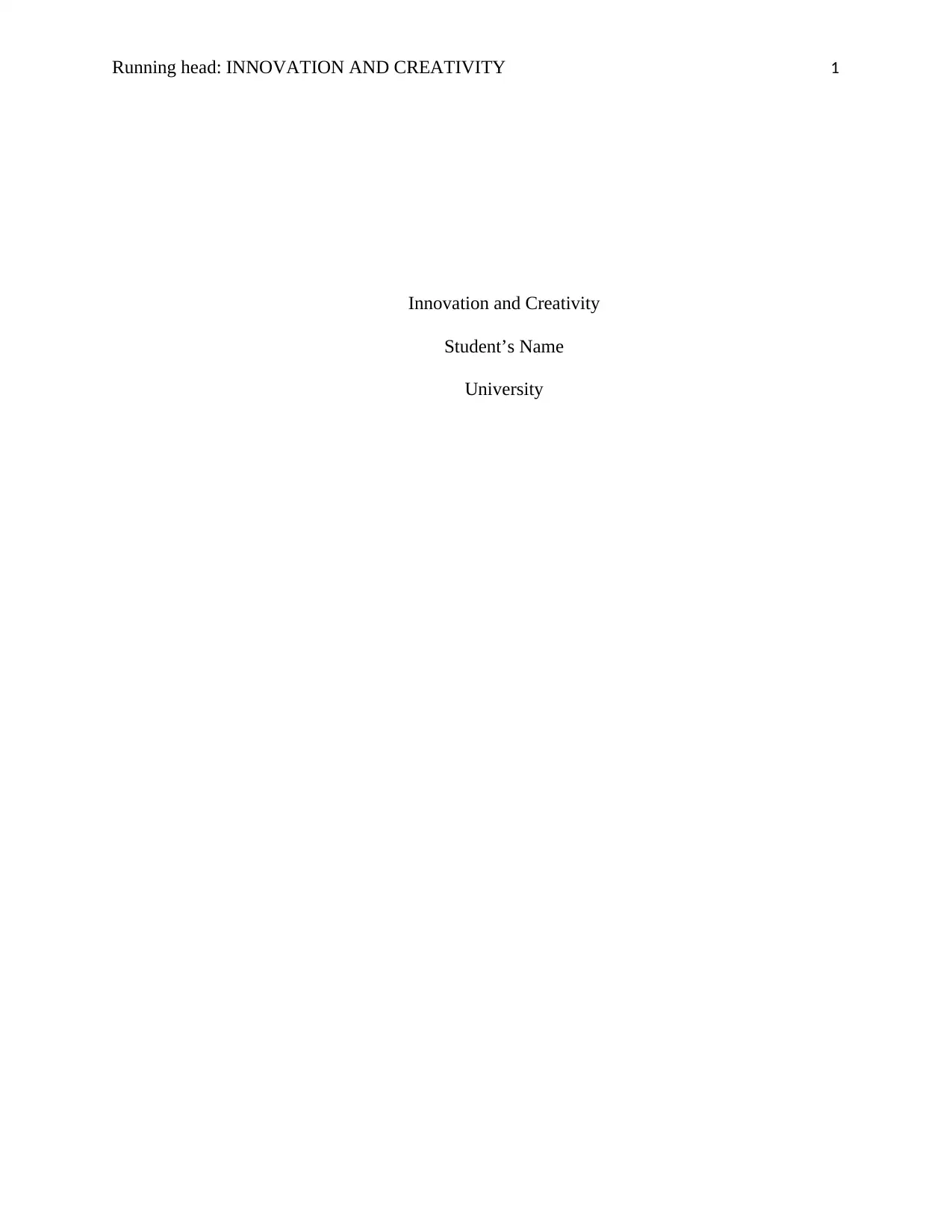
Running head: INNOVATION AND CREATIVITY 1
Innovation and Creativity
Student’s Name
University
Innovation and Creativity
Student’s Name
University
Secure Best Marks with AI Grader
Need help grading? Try our AI Grader for instant feedback on your assignments.
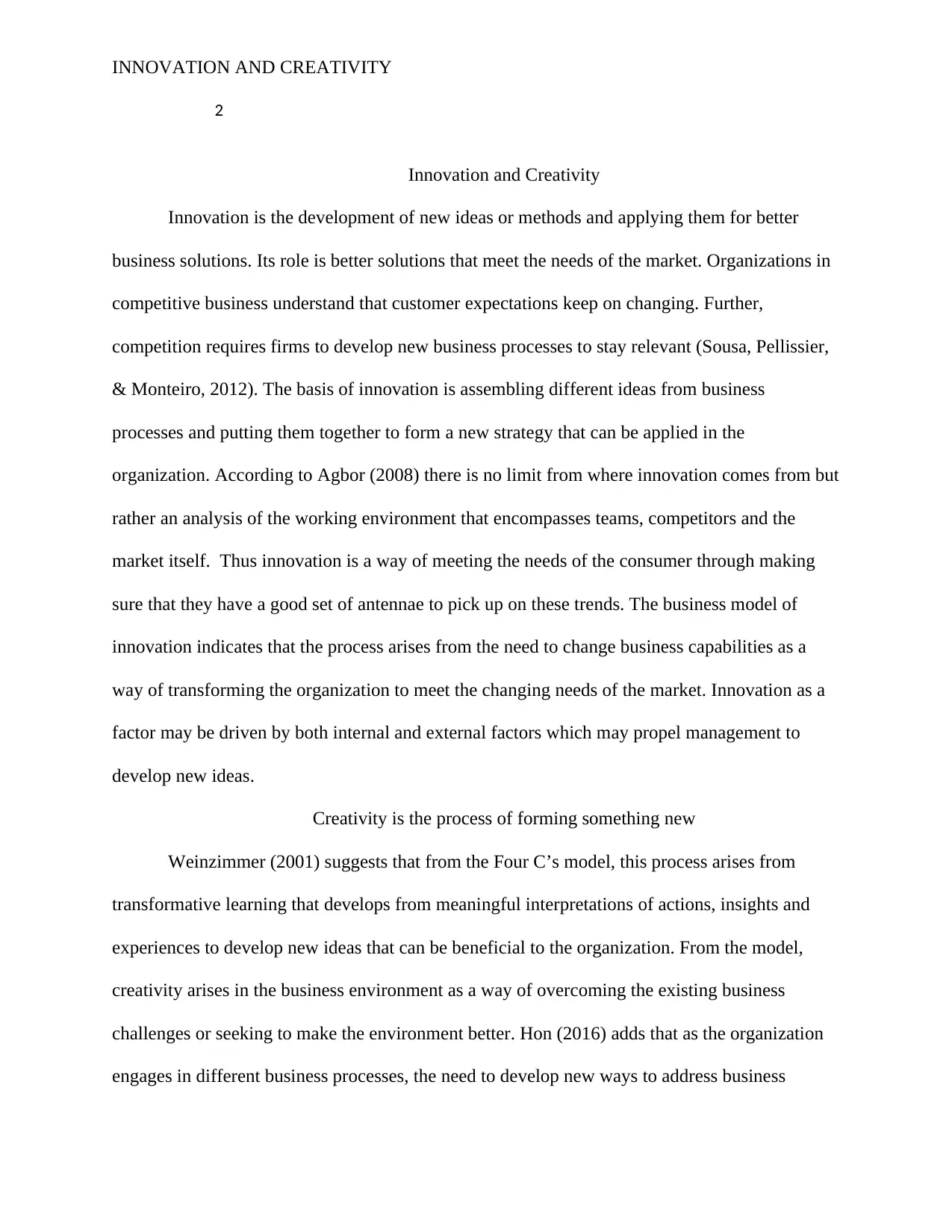
INNOVATION AND CREATIVITY
2
Innovation and Creativity
Innovation is the development of new ideas or methods and applying them for better
business solutions. Its role is better solutions that meet the needs of the market. Organizations in
competitive business understand that customer expectations keep on changing. Further,
competition requires firms to develop new business processes to stay relevant (Sousa, Pellissier,
& Monteiro, 2012). The basis of innovation is assembling different ideas from business
processes and putting them together to form a new strategy that can be applied in the
organization. According to Agbor (2008) there is no limit from where innovation comes from but
rather an analysis of the working environment that encompasses teams, competitors and the
market itself. Thus innovation is a way of meeting the needs of the consumer through making
sure that they have a good set of antennae to pick up on these trends. The business model of
innovation indicates that the process arises from the need to change business capabilities as a
way of transforming the organization to meet the changing needs of the market. Innovation as a
factor may be driven by both internal and external factors which may propel management to
develop new ideas.
Creativity is the process of forming something new
Weinzimmer (2001) suggests that from the Four C’s model, this process arises from
transformative learning that develops from meaningful interpretations of actions, insights and
experiences to develop new ideas that can be beneficial to the organization. From the model,
creativity arises in the business environment as a way of overcoming the existing business
challenges or seeking to make the environment better. Hon (2016) adds that as the organization
engages in different business processes, the need to develop new ways to address business
2
Innovation and Creativity
Innovation is the development of new ideas or methods and applying them for better
business solutions. Its role is better solutions that meet the needs of the market. Organizations in
competitive business understand that customer expectations keep on changing. Further,
competition requires firms to develop new business processes to stay relevant (Sousa, Pellissier,
& Monteiro, 2012). The basis of innovation is assembling different ideas from business
processes and putting them together to form a new strategy that can be applied in the
organization. According to Agbor (2008) there is no limit from where innovation comes from but
rather an analysis of the working environment that encompasses teams, competitors and the
market itself. Thus innovation is a way of meeting the needs of the consumer through making
sure that they have a good set of antennae to pick up on these trends. The business model of
innovation indicates that the process arises from the need to change business capabilities as a
way of transforming the organization to meet the changing needs of the market. Innovation as a
factor may be driven by both internal and external factors which may propel management to
develop new ideas.
Creativity is the process of forming something new
Weinzimmer (2001) suggests that from the Four C’s model, this process arises from
transformative learning that develops from meaningful interpretations of actions, insights and
experiences to develop new ideas that can be beneficial to the organization. From the model,
creativity arises in the business environment as a way of overcoming the existing business
challenges or seeking to make the environment better. Hon (2016) adds that as the organization
engages in different business processes, the need to develop new ways to address business
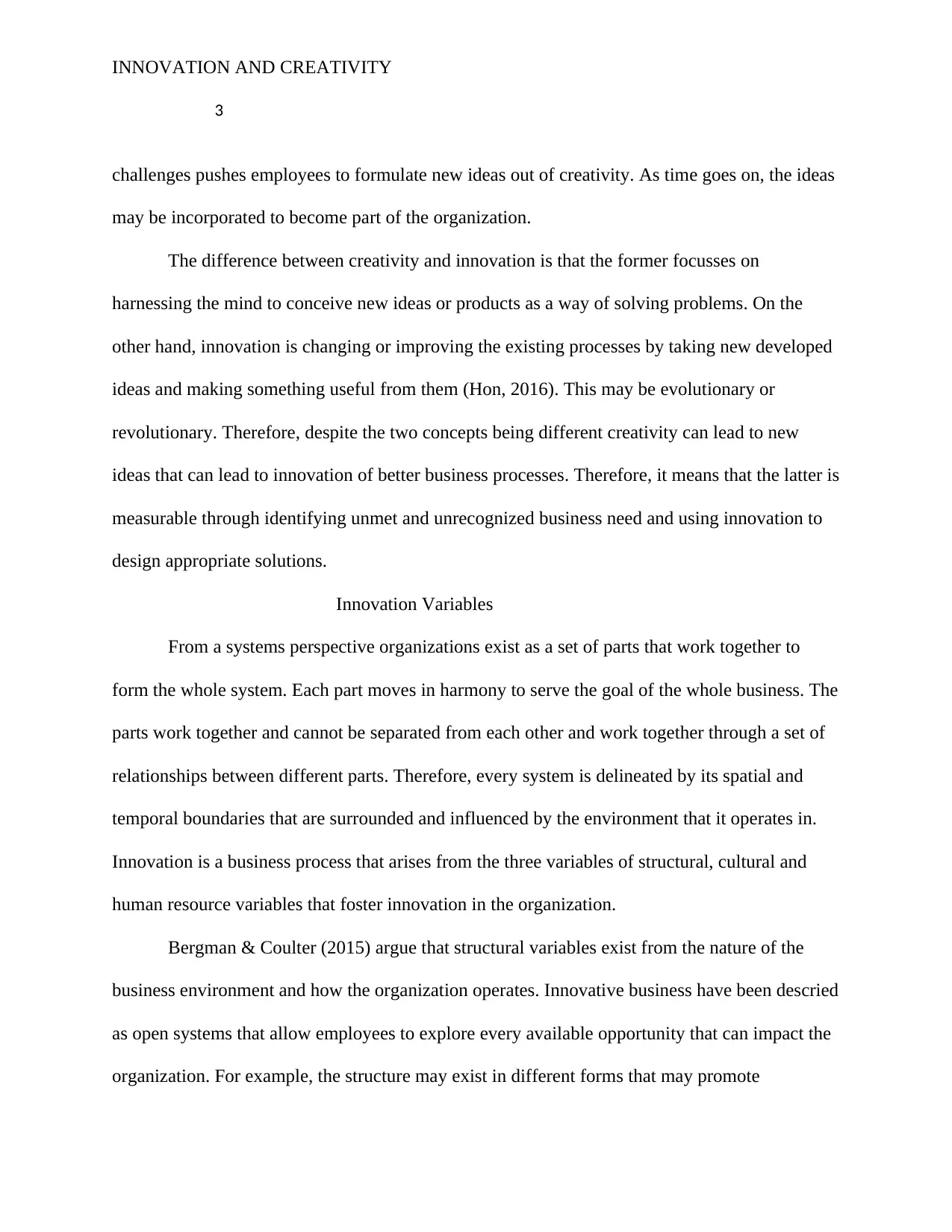
INNOVATION AND CREATIVITY
3
challenges pushes employees to formulate new ideas out of creativity. As time goes on, the ideas
may be incorporated to become part of the organization.
The difference between creativity and innovation is that the former focusses on
harnessing the mind to conceive new ideas or products as a way of solving problems. On the
other hand, innovation is changing or improving the existing processes by taking new developed
ideas and making something useful from them (Hon, 2016). This may be evolutionary or
revolutionary. Therefore, despite the two concepts being different creativity can lead to new
ideas that can lead to innovation of better business processes. Therefore, it means that the latter is
measurable through identifying unmet and unrecognized business need and using innovation to
design appropriate solutions.
Innovation Variables
From a systems perspective organizations exist as a set of parts that work together to
form the whole system. Each part moves in harmony to serve the goal of the whole business. The
parts work together and cannot be separated from each other and work together through a set of
relationships between different parts. Therefore, every system is delineated by its spatial and
temporal boundaries that are surrounded and influenced by the environment that it operates in.
Innovation is a business process that arises from the three variables of structural, cultural and
human resource variables that foster innovation in the organization.
Bergman & Coulter (2015) argue that structural variables exist from the nature of the
business environment and how the organization operates. Innovative business have been descried
as open systems that allow employees to explore every available opportunity that can impact the
organization. For example, the structure may exist in different forms that may promote
3
challenges pushes employees to formulate new ideas out of creativity. As time goes on, the ideas
may be incorporated to become part of the organization.
The difference between creativity and innovation is that the former focusses on
harnessing the mind to conceive new ideas or products as a way of solving problems. On the
other hand, innovation is changing or improving the existing processes by taking new developed
ideas and making something useful from them (Hon, 2016). This may be evolutionary or
revolutionary. Therefore, despite the two concepts being different creativity can lead to new
ideas that can lead to innovation of better business processes. Therefore, it means that the latter is
measurable through identifying unmet and unrecognized business need and using innovation to
design appropriate solutions.
Innovation Variables
From a systems perspective organizations exist as a set of parts that work together to
form the whole system. Each part moves in harmony to serve the goal of the whole business. The
parts work together and cannot be separated from each other and work together through a set of
relationships between different parts. Therefore, every system is delineated by its spatial and
temporal boundaries that are surrounded and influenced by the environment that it operates in.
Innovation is a business process that arises from the three variables of structural, cultural and
human resource variables that foster innovation in the organization.
Bergman & Coulter (2015) argue that structural variables exist from the nature of the
business environment and how the organization operates. Innovative business have been descried
as open systems that allow employees to explore every available opportunity that can impact the
organization. For example, the structure may exist in different forms that may promote
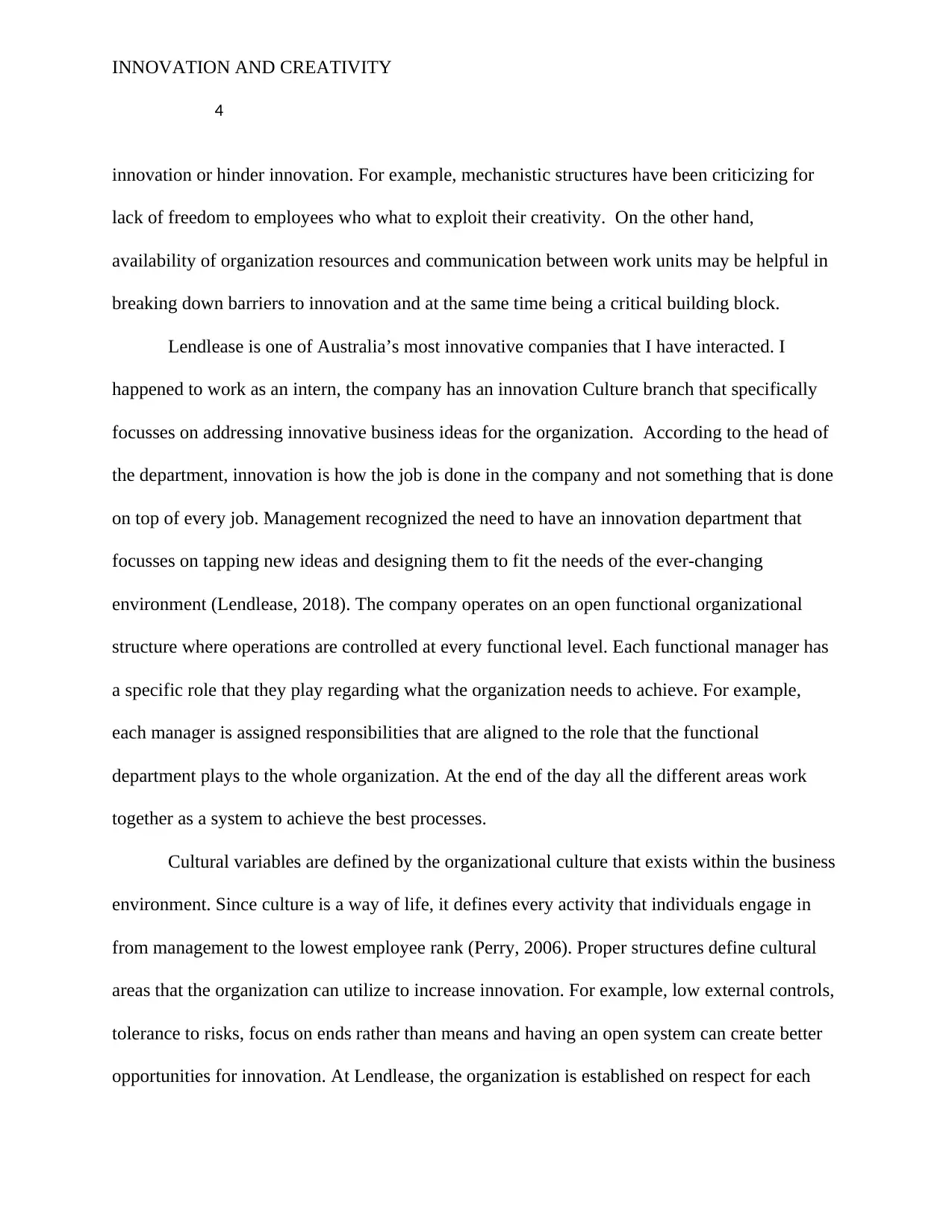
INNOVATION AND CREATIVITY
4
innovation or hinder innovation. For example, mechanistic structures have been criticizing for
lack of freedom to employees who what to exploit their creativity. On the other hand,
availability of organization resources and communication between work units may be helpful in
breaking down barriers to innovation and at the same time being a critical building block.
Lendlease is one of Australia’s most innovative companies that I have interacted. I
happened to work as an intern, the company has an innovation Culture branch that specifically
focusses on addressing innovative business ideas for the organization. According to the head of
the department, innovation is how the job is done in the company and not something that is done
on top of every job. Management recognized the need to have an innovation department that
focusses on tapping new ideas and designing them to fit the needs of the ever-changing
environment (Lendlease, 2018). The company operates on an open functional organizational
structure where operations are controlled at every functional level. Each functional manager has
a specific role that they play regarding what the organization needs to achieve. For example,
each manager is assigned responsibilities that are aligned to the role that the functional
department plays to the whole organization. At the end of the day all the different areas work
together as a system to achieve the best processes.
Cultural variables are defined by the organizational culture that exists within the business
environment. Since culture is a way of life, it defines every activity that individuals engage in
from management to the lowest employee rank (Perry, 2006). Proper structures define cultural
areas that the organization can utilize to increase innovation. For example, low external controls,
tolerance to risks, focus on ends rather than means and having an open system can create better
opportunities for innovation. At Lendlease, the organization is established on respect for each
4
innovation or hinder innovation. For example, mechanistic structures have been criticizing for
lack of freedom to employees who what to exploit their creativity. On the other hand,
availability of organization resources and communication between work units may be helpful in
breaking down barriers to innovation and at the same time being a critical building block.
Lendlease is one of Australia’s most innovative companies that I have interacted. I
happened to work as an intern, the company has an innovation Culture branch that specifically
focusses on addressing innovative business ideas for the organization. According to the head of
the department, innovation is how the job is done in the company and not something that is done
on top of every job. Management recognized the need to have an innovation department that
focusses on tapping new ideas and designing them to fit the needs of the ever-changing
environment (Lendlease, 2018). The company operates on an open functional organizational
structure where operations are controlled at every functional level. Each functional manager has
a specific role that they play regarding what the organization needs to achieve. For example,
each manager is assigned responsibilities that are aligned to the role that the functional
department plays to the whole organization. At the end of the day all the different areas work
together as a system to achieve the best processes.
Cultural variables are defined by the organizational culture that exists within the business
environment. Since culture is a way of life, it defines every activity that individuals engage in
from management to the lowest employee rank (Perry, 2006). Proper structures define cultural
areas that the organization can utilize to increase innovation. For example, low external controls,
tolerance to risks, focus on ends rather than means and having an open system can create better
opportunities for innovation. At Lendlease, the organization is established on respect for each
Secure Best Marks with AI Grader
Need help grading? Try our AI Grader for instant feedback on your assignments.
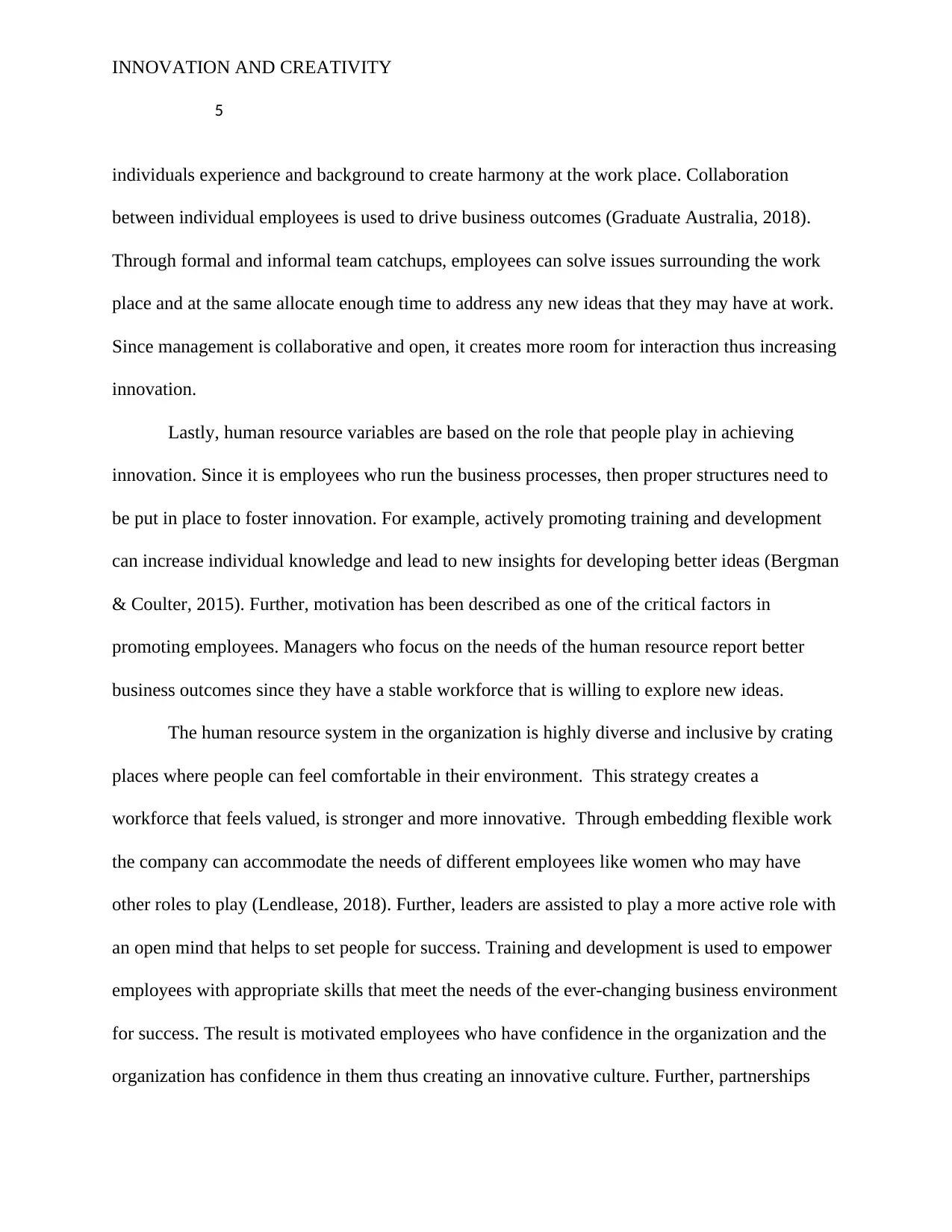
INNOVATION AND CREATIVITY
5
individuals experience and background to create harmony at the work place. Collaboration
between individual employees is used to drive business outcomes (Graduate Australia, 2018).
Through formal and informal team catchups, employees can solve issues surrounding the work
place and at the same allocate enough time to address any new ideas that they may have at work.
Since management is collaborative and open, it creates more room for interaction thus increasing
innovation.
Lastly, human resource variables are based on the role that people play in achieving
innovation. Since it is employees who run the business processes, then proper structures need to
be put in place to foster innovation. For example, actively promoting training and development
can increase individual knowledge and lead to new insights for developing better ideas (Bergman
& Coulter, 2015). Further, motivation has been described as one of the critical factors in
promoting employees. Managers who focus on the needs of the human resource report better
business outcomes since they have a stable workforce that is willing to explore new ideas.
The human resource system in the organization is highly diverse and inclusive by crating
places where people can feel comfortable in their environment. This strategy creates a
workforce that feels valued, is stronger and more innovative. Through embedding flexible work
the company can accommodate the needs of different employees like women who may have
other roles to play (Lendlease, 2018). Further, leaders are assisted to play a more active role with
an open mind that helps to set people for success. Training and development is used to empower
employees with appropriate skills that meet the needs of the ever-changing business environment
for success. The result is motivated employees who have confidence in the organization and the
organization has confidence in them thus creating an innovative culture. Further, partnerships
5
individuals experience and background to create harmony at the work place. Collaboration
between individual employees is used to drive business outcomes (Graduate Australia, 2018).
Through formal and informal team catchups, employees can solve issues surrounding the work
place and at the same allocate enough time to address any new ideas that they may have at work.
Since management is collaborative and open, it creates more room for interaction thus increasing
innovation.
Lastly, human resource variables are based on the role that people play in achieving
innovation. Since it is employees who run the business processes, then proper structures need to
be put in place to foster innovation. For example, actively promoting training and development
can increase individual knowledge and lead to new insights for developing better ideas (Bergman
& Coulter, 2015). Further, motivation has been described as one of the critical factors in
promoting employees. Managers who focus on the needs of the human resource report better
business outcomes since they have a stable workforce that is willing to explore new ideas.
The human resource system in the organization is highly diverse and inclusive by crating
places where people can feel comfortable in their environment. This strategy creates a
workforce that feels valued, is stronger and more innovative. Through embedding flexible work
the company can accommodate the needs of different employees like women who may have
other roles to play (Lendlease, 2018). Further, leaders are assisted to play a more active role with
an open mind that helps to set people for success. Training and development is used to empower
employees with appropriate skills that meet the needs of the ever-changing business environment
for success. The result is motivated employees who have confidence in the organization and the
organization has confidence in them thus creating an innovative culture. Further, partnerships
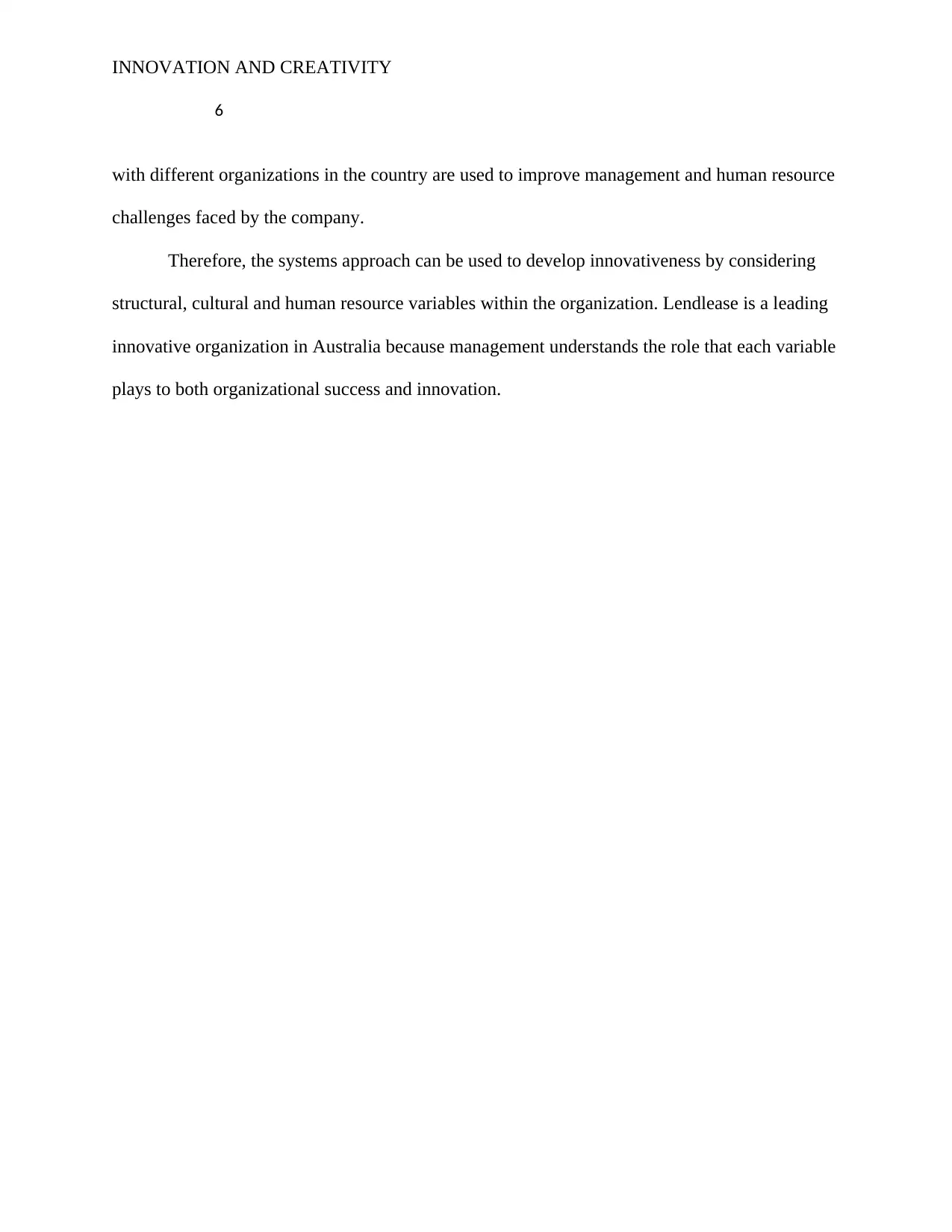
INNOVATION AND CREATIVITY
6
with different organizations in the country are used to improve management and human resource
challenges faced by the company.
Therefore, the systems approach can be used to develop innovativeness by considering
structural, cultural and human resource variables within the organization. Lendlease is a leading
innovative organization in Australia because management understands the role that each variable
plays to both organizational success and innovation.
6
with different organizations in the country are used to improve management and human resource
challenges faced by the company.
Therefore, the systems approach can be used to develop innovativeness by considering
structural, cultural and human resource variables within the organization. Lendlease is a leading
innovative organization in Australia because management understands the role that each variable
plays to both organizational success and innovation.
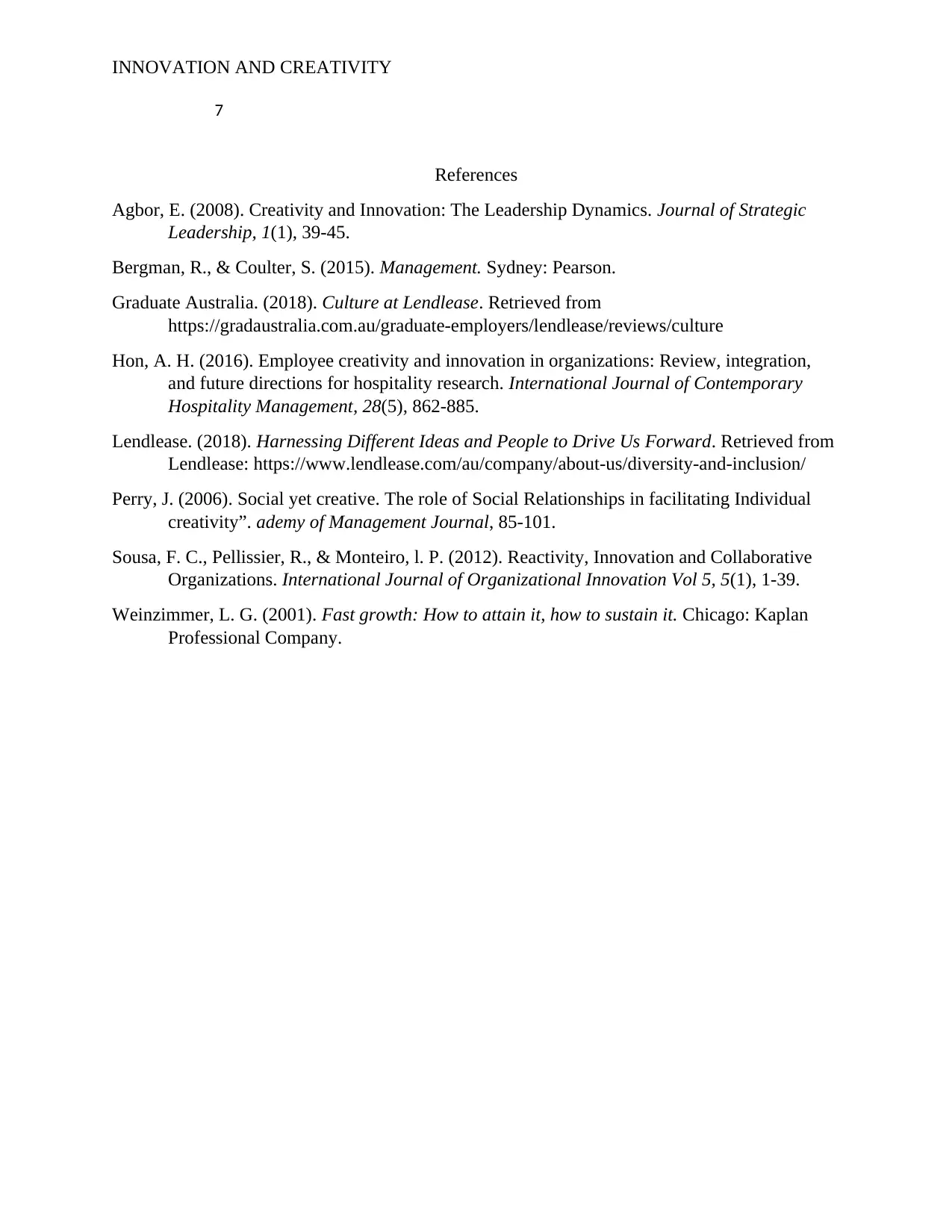
INNOVATION AND CREATIVITY
7
References
Agbor, E. (2008). Creativity and Innovation: The Leadership Dynamics. Journal of Strategic
Leadership, 1(1), 39-45.
Bergman, R., & Coulter, S. (2015). Management. Sydney: Pearson.
Graduate Australia. (2018). Culture at Lendlease. Retrieved from
https://gradaustralia.com.au/graduate-employers/lendlease/reviews/culture
Hon, A. H. (2016). Employee creativity and innovation in organizations: Review, integration,
and future directions for hospitality research. International Journal of Contemporary
Hospitality Management, 28(5), 862-885.
Lendlease. (2018). Harnessing Different Ideas and People to Drive Us Forward. Retrieved from
Lendlease: https://www.lendlease.com/au/company/about-us/diversity-and-inclusion/
Perry, J. (2006). Social yet creative. The role of Social Relationships in facilitating Individual
creativity”. ademy of Management Journal, 85-101.
Sousa, F. C., Pellissier, R., & Monteiro, l. P. (2012). Reactivity, Innovation and Collaborative
Organizations. International Journal of Organizational Innovation Vol 5, 5(1), 1-39.
Weinzimmer, L. G. (2001). Fast growth: How to attain it, how to sustain it. Chicago: Kaplan
Professional Company.
7
References
Agbor, E. (2008). Creativity and Innovation: The Leadership Dynamics. Journal of Strategic
Leadership, 1(1), 39-45.
Bergman, R., & Coulter, S. (2015). Management. Sydney: Pearson.
Graduate Australia. (2018). Culture at Lendlease. Retrieved from
https://gradaustralia.com.au/graduate-employers/lendlease/reviews/culture
Hon, A. H. (2016). Employee creativity and innovation in organizations: Review, integration,
and future directions for hospitality research. International Journal of Contemporary
Hospitality Management, 28(5), 862-885.
Lendlease. (2018). Harnessing Different Ideas and People to Drive Us Forward. Retrieved from
Lendlease: https://www.lendlease.com/au/company/about-us/diversity-and-inclusion/
Perry, J. (2006). Social yet creative. The role of Social Relationships in facilitating Individual
creativity”. ademy of Management Journal, 85-101.
Sousa, F. C., Pellissier, R., & Monteiro, l. P. (2012). Reactivity, Innovation and Collaborative
Organizations. International Journal of Organizational Innovation Vol 5, 5(1), 1-39.
Weinzimmer, L. G. (2001). Fast growth: How to attain it, how to sustain it. Chicago: Kaplan
Professional Company.
1 out of 7
Related Documents
Your All-in-One AI-Powered Toolkit for Academic Success.
+13062052269
info@desklib.com
Available 24*7 on WhatsApp / Email
![[object Object]](/_next/static/media/star-bottom.7253800d.svg)
Unlock your academic potential
© 2024 | Zucol Services PVT LTD | All rights reserved.




